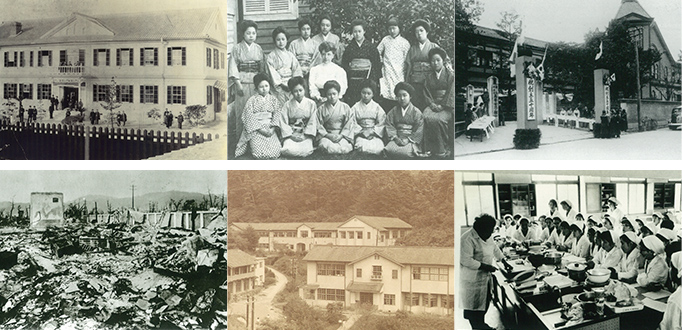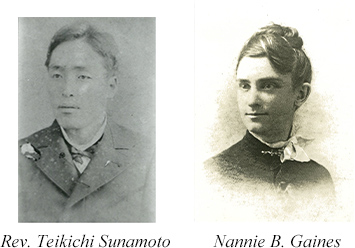History
139 Years of History

Hiroshima Jogakkai was founded in 1886 by Rev. Teikichi Sunamoto, a devout Christian with a strong desire to develop women’s education in his hometown of Hiroshima. The following year, a 27-year-old American missionary, Miss Nannie B. Gaines, was invited to be the first principal of what would become the first school for women’s education in Hiroshima. Through the years, the school faced many difficulties—Japanese government policy toward the separation of education and religion, the accidental burning of several school buildings, the disruption of World War II, and the tragedy of the atomic bombing. Through its foundation based on Christian principles of faith and prayer, Hiroshima Jogakuin has overcome many struggles, strong in its belief that it would never be defeated by any difficulty or disaster. “Human education based on Christianity” is our founding spirit.
Hiroshima Jogakuin University is a higher learning institution for women consisting of the Faculty of Humanities, the Faculty of Human Life Studies and the Graduate School. The total enrollment including international students is 639.

- 1886
- The Rev. Teikichi Sunamoto, after returning from the US, started a school for girls, named ‘Hiroshima Jogakkai’. Reading, morals and English were taught at first.
- 1887
- The school was renamed ‘Hiroshima Eiwa Jogakko’. Miss Nannie B. Gaines (1860–1932) was sent here from her church in the US.
- 1889
- Miss Gaines became the first principal of the school which consisted of the General, Regular and Special Courses.
- 1892
- The new school building was constructed. It became popular among local people because it was one of the first western-style building in Hiroshima. The attached kindergarten was founded.
- 1893
- The attached primary school was established, which implemented a consistent education program including the Kindergarten, Primary, Regular and Advanced Regular Courses.
- 1895
- The training program for nursery staff started.
- 1896
- The institution was renamed into ‘Hiroshima Jogakko’.
- 1906
- The school was approved as an incorporated foundation.
- 1908
- The Primary Course was abolished due to the school system reform. The Nursery Staff Course was set up in the Advanced Course.
- 1916
- After the abolition of the Advanced Course, one for Training Teachers was established.
- 1920
- The Specialty Division, consisting of Department of English Literature, Home Economics and School Training, was added and the independent school system of three divisions (Specialty, General and Elementary) was established.
- 1922
- The General Course changed its name to the Women’s Higher Educational Division and the School Training Division was abolished.
- 1925
- The Specialty Division was renamed as ‘Karejji (college)’.
- 1932
- The school changed its name again to the present Hiroshima Jogakuin. ‘Karejji’ was approved as one of the vocational schools which used to be the de facto highest educational institutions for girls under the prewar education system.
- 1940
- The wartime situation forced all the missionaries working for Hiroshima Jogakuin to return home.
- 1942
- The primary school was closed.
- 1944
- Because of the reform of the education system, while both Departments of English Literature and Home Economics were closed, the Economics, Healthcare and Clothing Departments were set up. The kindergarten was closed.
- 1945
- August 6, At 8:15 AM, an atomic bomb was dropped over Hiroshima, taking the lives of more than 350 students and teachers. All the school buildings were destroyed.
- 1946
- The vocational school was relocated from the original site in the downtown of Hiroshima to the property in the Ushita (the west side of the city) area where HJU is now located after the construction of tentative school buildings had been completed. The Department of Economics was closed and the Department of English was revived.
- 1947
- Hiroshima Jogakuin Junior High School was founded at the original site of downtown Hiroshima followed by the High School in 1948 under the newly enacted education law.
- 1949
- The former English Literature Department of the vocational school was promoted as a department of Hiroshima Jogakuin University. HJU was the first private university in Hiroshima prefecture as well as being included in the first batch of postwar new-system universities in Japan.
- 1950
- The other two departments (Home Economics and Clothing) belonging to the former vocational school were merged to be the one of Home Economics and promoted as Hiroshima Jogakuin Junior College.
- 1951
- The institution made a transition from an incorporated foundation to an incorporated school.
- 1960
- The main buildings of HJU were completed in the Ushita area.
- 1966
- The Department of Home Economics of the Junior College was split into the Home Economics Course and Nutrition and Food Course. In the following year the Faculty of English Literature was transformed into the Faculty of Literature that consisted of two departments of Japanese Literature and English and American Literature.
- 1981
- The third course, the Lifestyle Culture Course, was added to the Department of Home Economics of the Junior College.
- 1993
- The Department of Home Economics was transformed into the second faculty of HJU as the Faculty for Human Development.
- 1995
- The Master Degree Program of the Graduate School of Language and Culture was opened. The program consisted of two courses; Japanese Language and Culture, English Language and Culture.
- 1997
- The Doctoral Course of the Graduate School was opened. It consisted of courses continuing on from the Master Degree program.
- 1999
- The Master Degree Program of the Graduate School of Human Life Studies was opened which consisted of the Life and Culture Course and Life Science Course.
- 2000
- The Faculty of Literature established the Department of Human and Cultural Studies.
- 2004
- The two departments, Environmental Culture and Environmental Science, which had the Nutrition and Food Science Course and the Environmental Biology Course, were transformed into the Department of Life Design and Information and the Department of Nutrition and Health Promotion respectively.
- 2007
- The Department of Child Education and Psychology was established, and applications for the Department of Human and Cultural Studies were stopped.
- 2012
- The two faculties were reorganized into the Faculty of Liberal Arts and the Faculty of Human Life Science. The former contains the Department of Liberal Arts and the latter contains the three departments of Fashion and Architectural Design, Nutrition and Health Promotion, Child Education and Psychology.
- 2018
- Made a new start with the reorganization of faculties and departments. That is, the Faculty of Humanities comprising the two departments of International English, Japanese Language and Culture, the Faculty of Human Life Studies comprising the three departments of Life Design, Nutrition and Health and Childhood Education.
